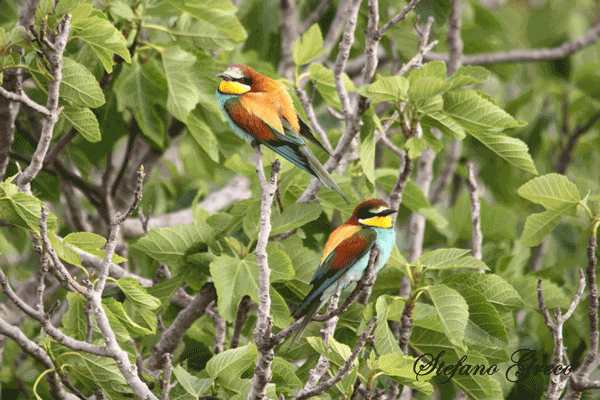Bee-eater
Share

 The bee-eater (Merops apiaster Linnaeus, 1758) is a tropical-looking bird, he has the colors of the rainbow, belongs to the family Meropidae.
The bee-eater (Merops apiaster Linnaeus, 1758) is a tropical-looking bird, he has the colors of the rainbow, belongs to the family Meropidae.
It feeds on insects, especially bees (Hymenoptera), hence the scientific name, (but also dragonflies, grasshoppers and beetles) that captures in flight. She has a habit of slamming the insect on a hard surface before eating it.
The bee-eaters are gregarious, nesting in colonies in sand banks, preferably along the banks of rivers, usually in early May. They dig a burrow 3-5 feet long even in the bottom of which lay 5-8 eggs. Only one brood a year in early June.
Both the male and the female take care of the eggs that are incubated for about 20 days.
In Italy, the Bee colonies are concentrated especially along the Po valley. {loadposition face} {loadposition gog} {loadposition twitter}
In Lampedusa are passing through, like everyone else, in the spring and early autumn. In Lampedusa are not looking hotel, but just a little bit of rest before facing the sea of the Sicily’s Channel and arrive at the mainland.
They are found in flocks formed by many specimens, a bit all over the island, sometimes even settle along the lines of electric current or along the fence of the airport of Lampedusa. Their song is unmistakable and often audible at a great distance (over-listen to it), but the particularity of these birds are their colors and for this reason they are also called rainbow birds. Their journey is long, from Europe, sub-Saharan africa cascade down to the end of the summer and then come back to us in the spring. The pictures of Bee Lampedusa made by Stefano Greco you can see them here
Very Beautiful is the documentary by Marco Paolo Pavese posted on youtube and visible here. The wings of the Rainbow. At the bottom right is also visible a modified tab of classification from wikipedia with the conservation status of the species, which as you see is threatened.
| Stato di conservazione | |||
|---|---|---|---|
|
|||
| Classificazione scientifica | |||
| Dominio | Eukaryota | ||
| Regno | Animalia | ||
| Sottoregno | Eumetazoa | ||
| Superphylum | Deuterostomia | ||
| Phylum | Chordata | ||
| Subphylum | Vertebrata | ||
| Infraphylum | Gnathostomata | ||
| Superclasse | Tetrapoda | ||
| Classe | Aves | ||
| Sottoclasse | Neornithes | ||
| Superordine | Neognathae | ||
| Ordine | Coraciiformes | ||
| Famiglia | Meropidae | ||
| Genere | Merops | ||
| Specie | M. apiaster | ||
| Nomenclatura binomiale | |||
| Merops apiaster Linnaeus, 1758 |
|||


